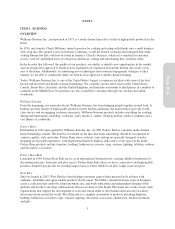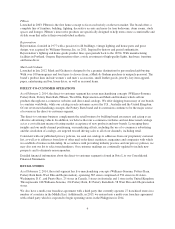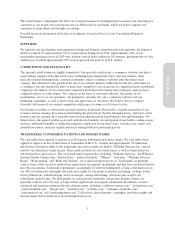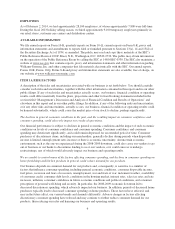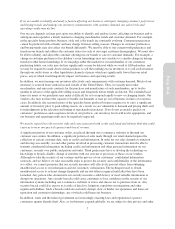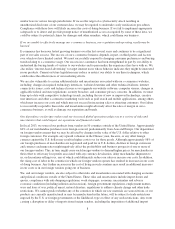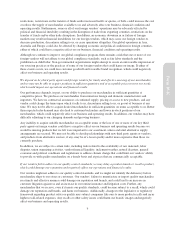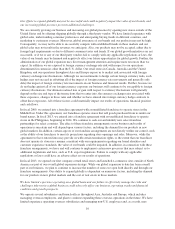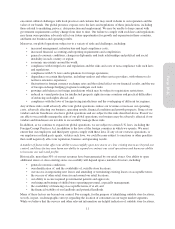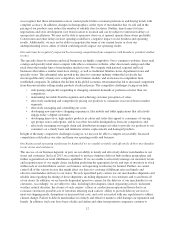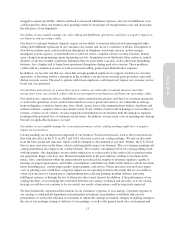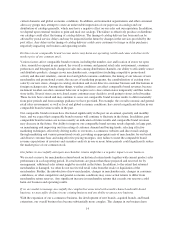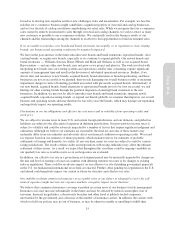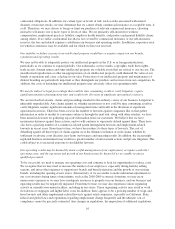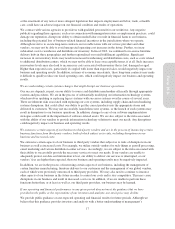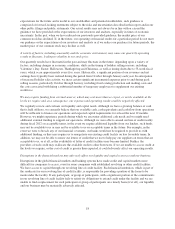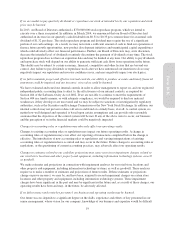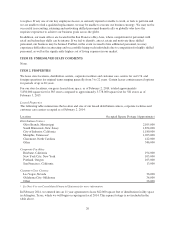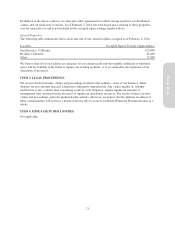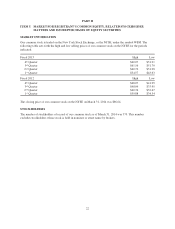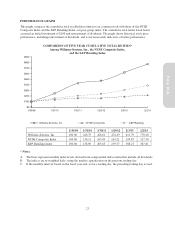Pottery Barn 2013 Annual Report Download - page 27
Download and view the complete annual report
Please find page 27 of the 2013 Pottery Barn annual report below. You can navigate through the pages in the report by either clicking on the pages listed below, or by using the keyword search tool below to find specific information within the annual report.
struggle to operate profitably, which could lead to increased fulfillment expenses. Any rise in fulfillment costs
could negatively affect our business and operating results by increasing our transportation costs and decreasing
the efficiency of our shipments.
Our failure to successfully manage our order-taking and fulfillment operations could have a negative impact on
our business and operating results.
Our direct-to-customer business depends, in part, on our ability to maintain efficient and uninterrupted order-
taking and fulfillment operations in our customer care centers and on our e-commerce websites. Disruptions or
slowdowns in these areas could result from disruptions in telephone or network services, power outages,
inadequate system capacity, system hardware or software issues, computer viruses, security breaches, human
error, changes in programming, union organizing activity, disruptions in our third party labor contracts, natural
disasters or adverse weather conditions. Industries that are particularly seasonal, such as the home furnishings
business, face a higher risk of harm from operational disruptions during peak sales seasons. These problems
could result in a reduction in sales as well as increased selling, general and administrative expenses.
In addition, we face the risk that we cannot hire enough qualified employees to support our direct-to-customer
operations, or that there will be a disruption in the workforce we hire from our third party providers, especially
during our peak season. The need to operate with fewer employees could negatively impact our customer service
levels and our operations.
Our facilities and systems, as well as those of our vendors, are vulnerable to natural disasters and other
unexpected events, any of which could result in an interruption in our business and harm our operating results.
Our retail stores, corporate offices, distribution centers, infrastructure projects and direct-to-customer operations,
as well as the operations of our vendors from which we receive goods and services, are vulnerable to damage
from earthquakes, tornadoes, hurricanes, fires, floods, power losses, telecommunications failures, hardware and
software failures, computer viruses and similar events. If any of these events result in damage to our facilities or
systems, or those of our vendors, we may experience interruptions in our business until the damage is repaired,
resulting in the potential loss of customers and revenues. In addition, we may incur costs in repairing any damage
beyond our applicable insurance coverage.
Our failure to successfully manage the costs and performance of our catalog mailings might have a negative
impact on our business.
Catalog mailings are an important component of our business. Postal rate increases, such as the recent increases
that went into effect in the U.S. in 2013 and 2014, affect the cost of our catalog mailings. We rely on discounts
from the basic postal rate structure, which could be changed or discontinued at any time. Further, the U.S. Postal
Service may raise rates in the future, which could negatively impact our business. The cost of paper, printing and
catalog distribution also impacts our catalog business. We recently consolidated all of our catalog printing work
with one printer. Our dependence on one vendor subjects us to various risks if the vendor fails to perform under
our agreement. Paper costs have also fluctuated significantly in the past and may continue to fluctuate in the
future. Also, consolidation within the paper industry has reduced the number of potential suppliers capable of
meeting our paper requirements, and further consolidation could limit our ability in the future to obtain favorable
terms including price, custom paper quality, paper quantity, and service. Future increases in postal rates, paper
costs or printing costs would have a negative impact on our operating results to the extent that we are unable to
offset such increases by raising prices, implementing more efficient printing, mailing, delivery and order
fulfillment systems, or through the use of alternative direct-mail formats. In addition, if the performance of our
catalogs declines, if we misjudge the correlation between our catalog circulation and net sales, or if our catalog
strategy overall does not continue to be successful, our results of operations could be negatively impacted.
We have historically experienced fluctuations in our customers’ response to our catalogs. Customer response to
our catalogs is substantially dependent on merchandise assortment, merchandise availability and creative
presentation, as well as the selection of customers to whom the catalogs are mailed, changes in mailing strategies,
the size of our mailings, timing of delivery of our mailings, as well as the general retail sales environment and
13
Form 10-K


